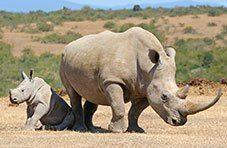Over the last period, we’ve been sharing some interesting facts about The Big Five – a group of difficult to poach animals the hunters have been passionately pursuing for ages. Nowadays, African lion, African elephant, Cape buffalo, African leopard and rhinoceros are called The Big Five by the tourist agencies using it to draw fans of ecotourism. Today we’ll try to learn a bit more about the one which has been around for millions of years, the African rhino.
Which is Black and Which is White?
There are 2 species of African rhino, Black and White. Black one is smaller but considered to be more dangerous because of its volatile temperament. White rhino is not actually white, it got its name from the word ‘weit’, which means wide. It’s a name the early Dutch settlers used for rhinos due to their wide muzzle. In fact, the two species are not easily distinguishable by colour.
Rhino is the second largest land mammal, after the elephant, weighing up to 1.5 to 2 tons. It’s got a massive body covered by thick protective skin, short neck and broad chest. There are two horns on its snout, one bigger than the other, which are made of keratin. This is actually the same type of protein that makes up our nails and hair.
This armoured giant has poor eyesight and will sometimes attack rocks and trees by accident. On the other hand, he has a fantastic sense of hearing and smell. His vocabulary includes a varieties of sounds, such as grunts, growls, snorts, squeaks and bellows. If you hear something that sounds like "mmwonk", you’ll know they are happy. When attacking, rhino will lower its head, snort and break into a gallop. Move out of its way or you’ll get stricken by its horns. Even if bulky, rhino is very agile, can run as fast as 40 km/h and quickly turn in a small space.
The Oxpecker, Rhino’s Best Friend
Females live together in small groups formed by mums and their young. A dominant male will sometimes allow sub-dominant ones to live on his territory. However, rhinos are often solitary, especially black ones, and will not look for each other’s company. They do mix with birds, though, and have formed a kind of symbiosis with the oxpecker. This little feathery friend will sit on rhino's back and eat the bugs that crawl on his skin. It will also warn its big buddy when danger approaches.
In our series of stories featuring unlikely friendships, an abandoned baby rhino called Osita made friends with a goat named Bokkie. She taught Osita how to graze, as her mum was not there to do it, and occasionally teased the little rhino, as friends do. When Osita was asleep, Bokkie would climb up his body and nestle comfortably on top of Osita’s head.
While capable of forming such unexpected relationships, rhinos are not very gentle with each other even when mating. Males and females will often fight during courtship, which sometimes results in serious wounds inflicted by their horns. Ladies reproduce every 2.5 to 5 years and the gestation period lasts 16 months. They usually only have one calf at a time and their babies are quite big, weighing 40 to 64 kg. The young ones will stay with their mums for 2 to 4 years before they leave home.
Non-Stop Grazing
These herbivores spend their days and nights grazing and, during the rare events when they are not eating, you’ll probably find them enjoying a mud bath. Like with elephants, the mud acts as a natural sunblock and traps the bugs which then fall off together with chunks of dried mud. The hottest part of the day is the only time rhino will sleep.
While they normally eat leafy material, rhinos’ diet varies by species due to different shapes of their snouts. Black rhino has long lip which enables him to pick leaves and fruit from up high, while white rhino can get closer to ground and eat grass.
The majority of the black rhino population is concentrated in four countries: South Africa, Namibia, Zimbabwe, and Kenya. You’ll find them in grassland, floodplains and open savanna. They will normally live for 35 to 40 years.
Predators: Humans
Hundred years ago, there were about 500,000 rhinos across Africa and Asia. Today, they estimate there’s only 20,000 white and 5,000 black rhinos left. IUCN lists them as Endangered (black rhino) and Near Threatened (white).
In the wild, adult rhinos have no predators except for humans. It’s their horns that make them target for hunters, catering primarily to Asian markets where rhino horns are used in ornamental carvings and traditional medicine. Habitat loss is another major threat. Even though these herbivores are big and tough, they are easily poached when quenching their thirst. Hunters easily ambush them at water holes where rhinos tend to go daily. Thanks to the conservation efforts in recent years, both species have increased in number, though poaching still remains a threat.




